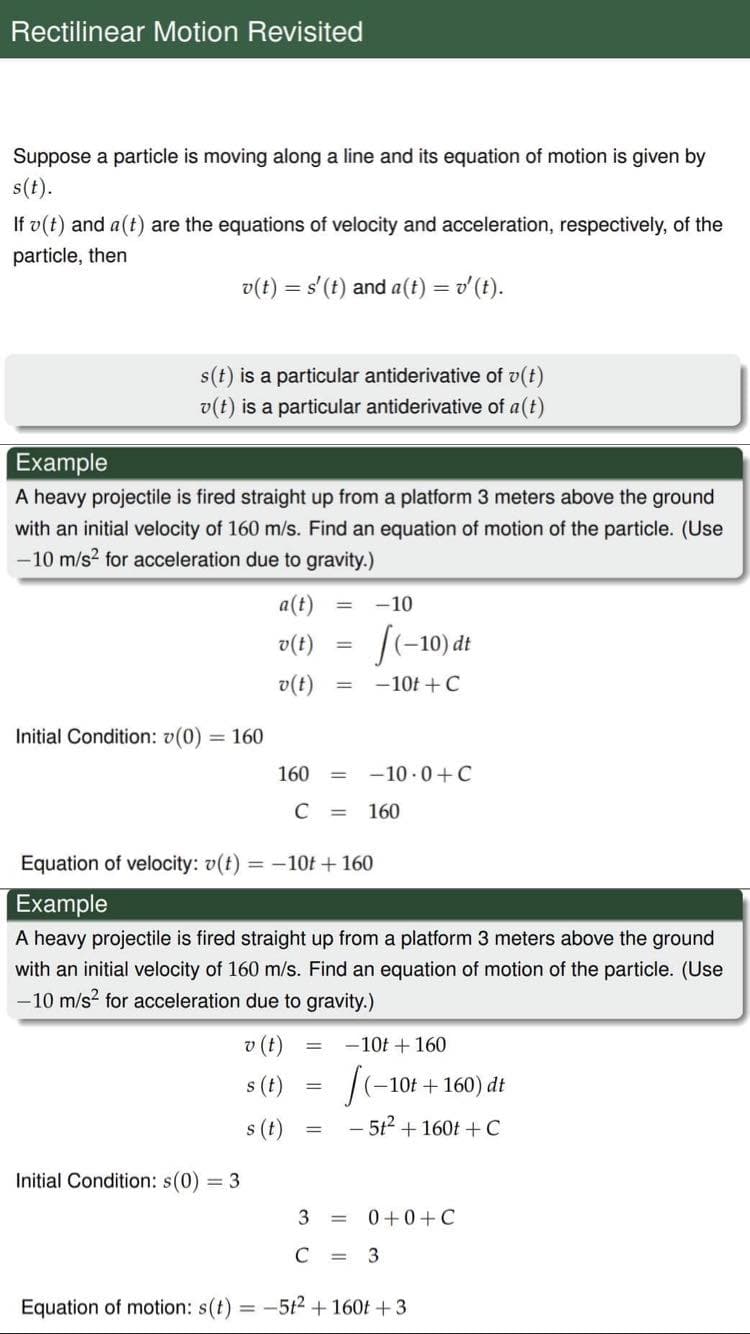A particle is moving along a horizontal path which starts at a distance of 5 ft to the right of a certain point P with an initial velocity of 4 ft/s. Another particle is also moving along the same path which starts at a distance of 3 ft to the left of P with an initial velocity of 8 ft/s. Suppose the acceleration of the two particles are given by a1 (t) = 2t – 3 and a2(t) = 2t – 5, respectively. Will the two particles collide? Justify your answer.
A particle is moving along a horizontal path which starts at a distance of 5 ft to the right of a certain point P with an initial velocity of 4 ft/s. Another particle is also moving along the same path which starts at a distance of 3 ft to the left of P with an initial velocity of 8 ft/s. Suppose the acceleration of the two particles are given by a1 (t) = 2t – 3 and a2(t) = 2t – 5, respectively. Will the two particles collide? Justify your answer.
Calculus: Early Transcendentals
8th Edition
ISBN:9781285741550
Author:James Stewart
Publisher:James Stewart
Chapter1: Functions And Models
Section: Chapter Questions
Problem 1RCC: (a) What is a function? What are its domain and range? (b) What is the graph of a function? (c) How...
Related questions
Question
Please answer this question using the Particular Antiderivatives: Application to Rectilinear Motion.
The following slides given could be a guide to answer the question.

Transcribed Image Text:A particle is moving along a horizontal path which starts at a distance of 5 ft to the right of a certain point
P with an initial velocity of 4 ft/s. Another particle is also moving along the same path which starts at
a distance of 3 ft to the left of P with an initial velocity of 8 ft/s. Suppose the acceleration of the two
particles are given by a1 (t) = 2t – 3 and a2(t) = 2t – 5, respectively. Will the two particles collide? Justify
your answer.

Transcribed Image Text:Rectilinear Motion Revisited
Suppose a particle is moving along a line and its equation of motion is given by
s(t).
If v(t) and a(t) are the equations of velocity and acceleration, respectively, of the
particle, then
v(t) = s'(t) and a(t) = v'(t).
s(t) is a particular antiderivative of v(t)
v(t) is a particular antiderivative of a(t)
Example
A heavy projectile is fired straight up from a platform 3 meters above the ground
with an initial velocity of 160 m/s. Find an equation of motion of the particle. (Use
-10 m/s2 for acceleration due to gravity.)
a(t)
-10
[(-10) đt
v(t)
-10t +C
(1)a
Initial Condition: v(0) = 160
160
-10 - 0+C
%3D
C
160
%3D
Equation of velocity: v(t)
= -10t +160
Example
A heavy projectile is fired straight up from a platform 3 meters above the ground
with an initial velocity of 160 m/s. Find an equation of motion of the particle. (Use
-10 m/s? for acceleration due to gravity.)
v (t)
-10t + 160
s (t)
-10t+160) dt
s (t)
- 512 + 160t +C
Initial Condition: s(0) = 3
3
0 +0+C
C
3
Equation of motion: s(t)
-512 + 160t +3
Expert Solution
This question has been solved!
Explore an expertly crafted, step-by-step solution for a thorough understanding of key concepts.
Step by step
Solved in 3 steps with 2 images

Recommended textbooks for you

Calculus: Early Transcendentals
Calculus
ISBN:
9781285741550
Author:
James Stewart
Publisher:
Cengage Learning

Thomas' Calculus (14th Edition)
Calculus
ISBN:
9780134438986
Author:
Joel R. Hass, Christopher E. Heil, Maurice D. Weir
Publisher:
PEARSON

Calculus: Early Transcendentals (3rd Edition)
Calculus
ISBN:
9780134763644
Author:
William L. Briggs, Lyle Cochran, Bernard Gillett, Eric Schulz
Publisher:
PEARSON

Calculus: Early Transcendentals
Calculus
ISBN:
9781285741550
Author:
James Stewart
Publisher:
Cengage Learning

Thomas' Calculus (14th Edition)
Calculus
ISBN:
9780134438986
Author:
Joel R. Hass, Christopher E. Heil, Maurice D. Weir
Publisher:
PEARSON

Calculus: Early Transcendentals (3rd Edition)
Calculus
ISBN:
9780134763644
Author:
William L. Briggs, Lyle Cochran, Bernard Gillett, Eric Schulz
Publisher:
PEARSON

Calculus: Early Transcendentals
Calculus
ISBN:
9781319050740
Author:
Jon Rogawski, Colin Adams, Robert Franzosa
Publisher:
W. H. Freeman


Calculus: Early Transcendental Functions
Calculus
ISBN:
9781337552516
Author:
Ron Larson, Bruce H. Edwards
Publisher:
Cengage Learning